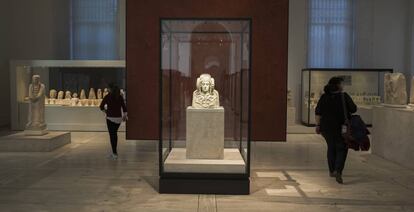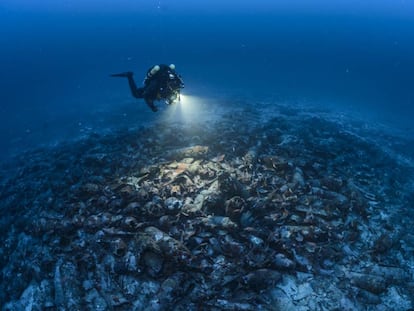Why the Lady and the ant is no joke for Spain’s Valencia region
National Archaeological Museum under fire after insect discovered inside case of treasure

Someone at Spain’s National Archaeological Museum (MAN) has some explaining to do after a visitor posted a video on Twitter on Friday of an ant crawling around inside the glass case – supposedly airtight – housing the Lady of Elche, a national treasure dating back to the fifth century BC named after the town in Valencia where it was discovered and that some in the Mediterranean region want returned.
On Tuesday, Charles Mulet, a senator from Valencia, told the regional parliament there that the incident proves the Madrid museum is not fit to look after the sculpture and that it should be returned to Valencia.
You can silence an ant, but not the whole anthill Campaign slogan to have the Lady of Elche returned
“None of the minimal protocols” were followed by the museum, said Mulet, explaining the ant's entry into the case. “That would never have happened to the Lady of Elche in her place of origin,” he said. Mulet continued: “this is a symptom of the greed of a centralist government that believes only people in the capital should enjoy important archaeological finds, despite being a city that has not contributed anything significant” to the museum’s collection.
In short, said Mulet, if Madrid cannot look after the sculpture, then it should be returned to Valencia.
The MAN, the Ministry of Education, Culture and Sport said in a joint statement that they have begun to check the cases housing artifacts and have increased pest control following the incident. According to the statement, “the sculpture is made of inorganic material (limestone) and cannot be affected by insects. In any case, conservation experts at the museum have carried out a review of the piece and say it is in perfect condition.”
The director of the MAN, Andrés Carretero, said: “technicians and museum staff acted quickly. As soon as they detected the presence of the small creature in the case, they notified the conservation department to proceed with its removal. Subsequently, a rapid disinfection treatment was carried out. Since then, no other insects have been detected in any of the exhibition facilities in the museum.”
A comprehensive review will be carried out to find out how the ant entered the showcase
The Lady of Elche was found in L'Alcúdia in 1897 and bought by a French archaeologist. It was first displayed at the Louvre Museum in Paris. In 1941, it was moved to the Prado Museum in Madrid and later moved to the National Archaeological Museum. Regional politicians in Valencia have long argued it should be returned.
On August 4, the mayor of Elche, Carlos González, announced he had asked Madrid to have the sculpture displayed during the first half of 2018 in the town. As expected, the answer was negative, citing security measures. Then the ant showed up. González, on his personal Twitter account, broadcast a video saying, “We do not know if it is a matter of concern, or just a mistake, but we need an explanation and guarantee that the Lady is properly protected and preserved."
Visit Elche, a tourism organization based in the Valencian city of Alicante, has launched a social media campaign calling for the return of the bust to its original home, saying: “You can silence an ant, but not the whole anthill.”
English version by Debora Almeida.
Tu suscripción se está usando en otro dispositivo
¿Quieres añadir otro usuario a tu suscripción?
Si continúas leyendo en este dispositivo, no se podrá leer en el otro.
FlechaTu suscripción se está usando en otro dispositivo y solo puedes acceder a EL PAÍS desde un dispositivo a la vez.
Si quieres compartir tu cuenta, cambia tu suscripción a la modalidad Premium, así podrás añadir otro usuario. Cada uno accederá con su propia cuenta de email, lo que os permitirá personalizar vuestra experiencia en EL PAÍS.
¿Tienes una suscripción de empresa? Accede aquí para contratar más cuentas.
En el caso de no saber quién está usando tu cuenta, te recomendamos cambiar tu contraseña aquí.
Si decides continuar compartiendo tu cuenta, este mensaje se mostrará en tu dispositivo y en el de la otra persona que está usando tu cuenta de forma indefinida, afectando a tu experiencia de lectura. Puedes consultar aquí los términos y condiciones de la suscripción digital.
More information
Archived In
Últimas noticias
Most viewed
- Reinhard Genzel, Nobel laureate in physics: ‘One-minute videos will never give you the truth’
- Pablo Escobar’s hippos: A serious environmental problem, 40 years on
- Charles Dubouloz, mountaineering star, retires at 36 with a farewell tour inspired by Walter Bonatti
- Why we lost the habit of sleeping in two segments and how that changed our sense of time
- The Florida Keys tourist paradise is besieged by immigration agents: ‘We’ve never seen anything like this’










































